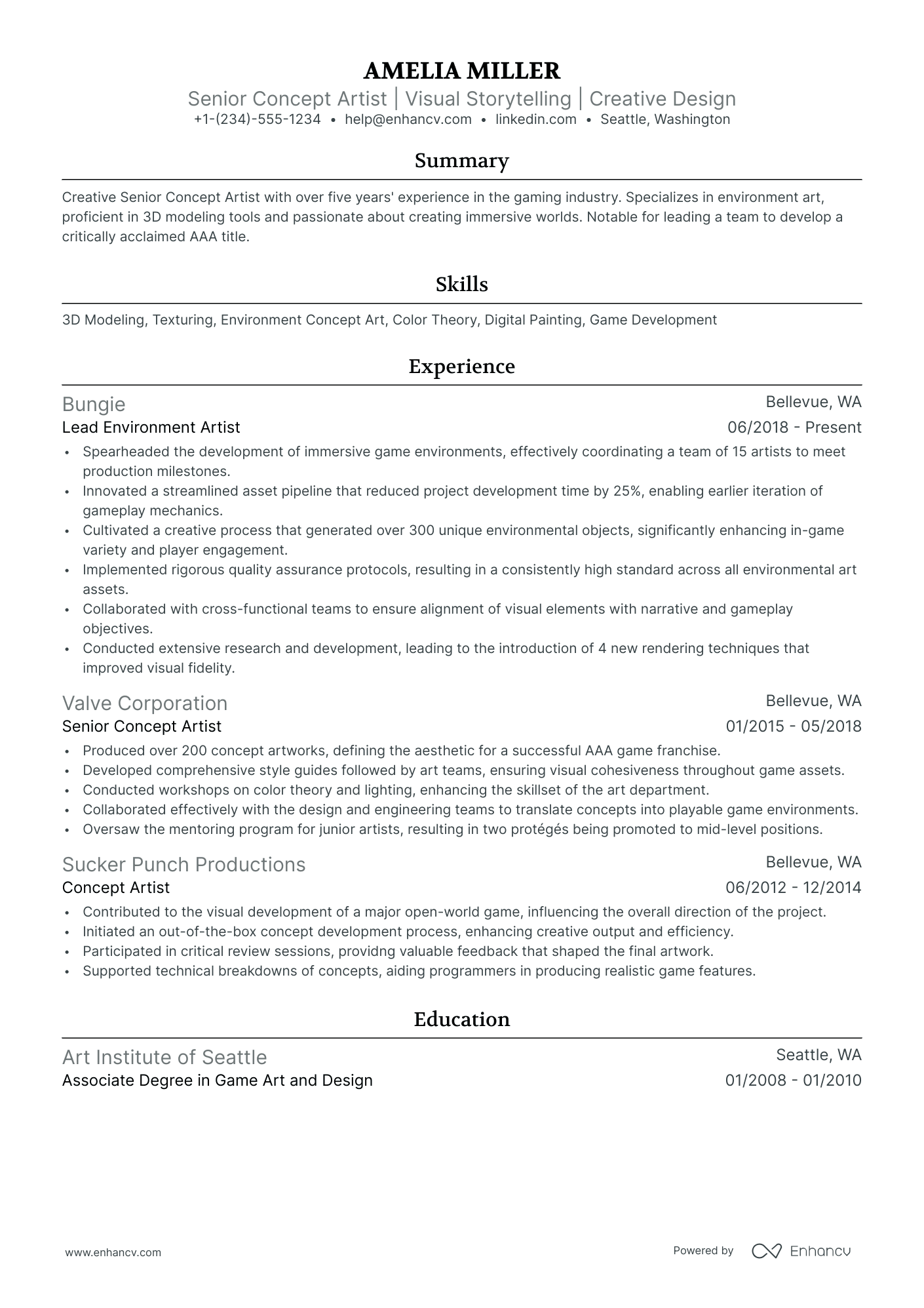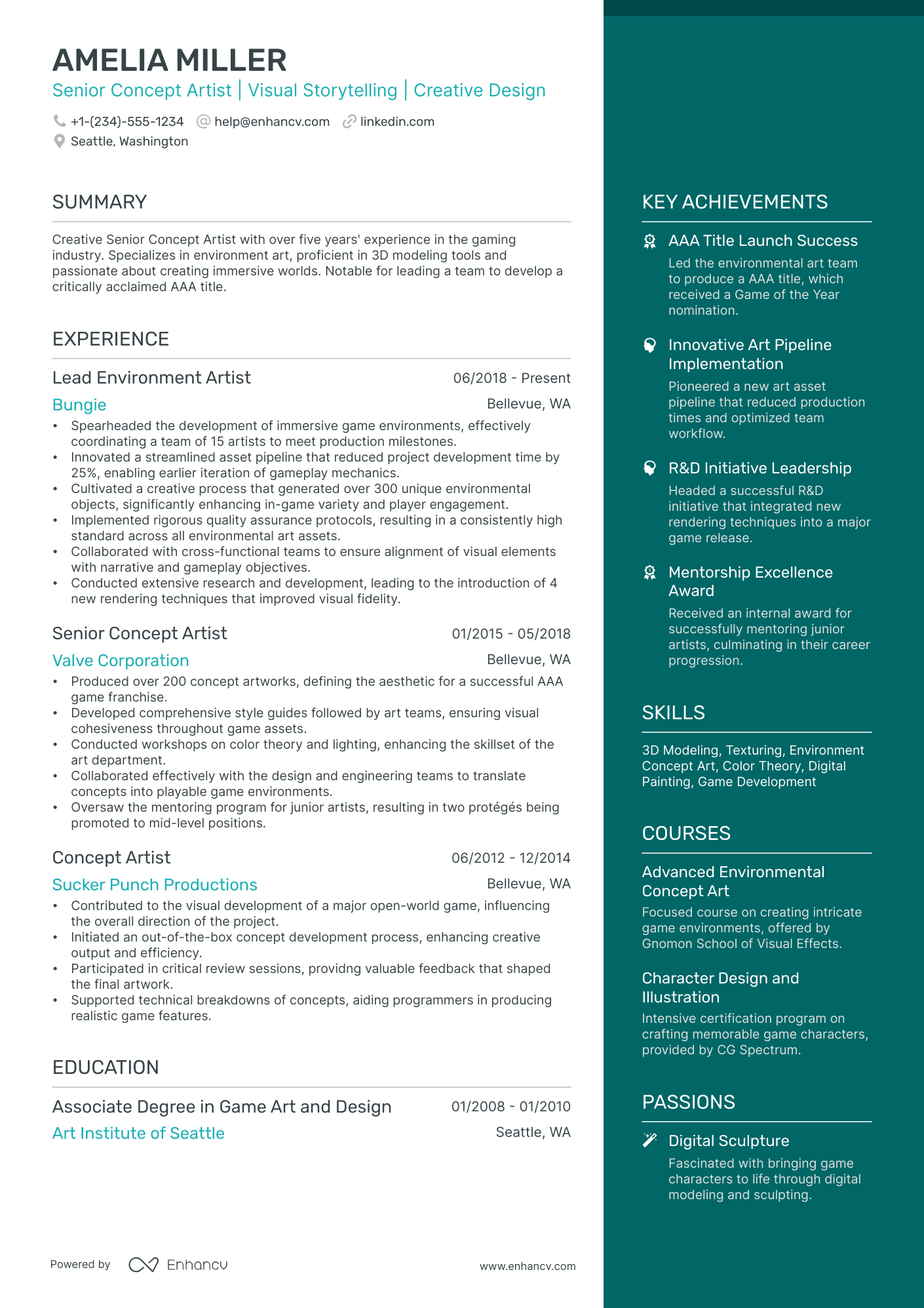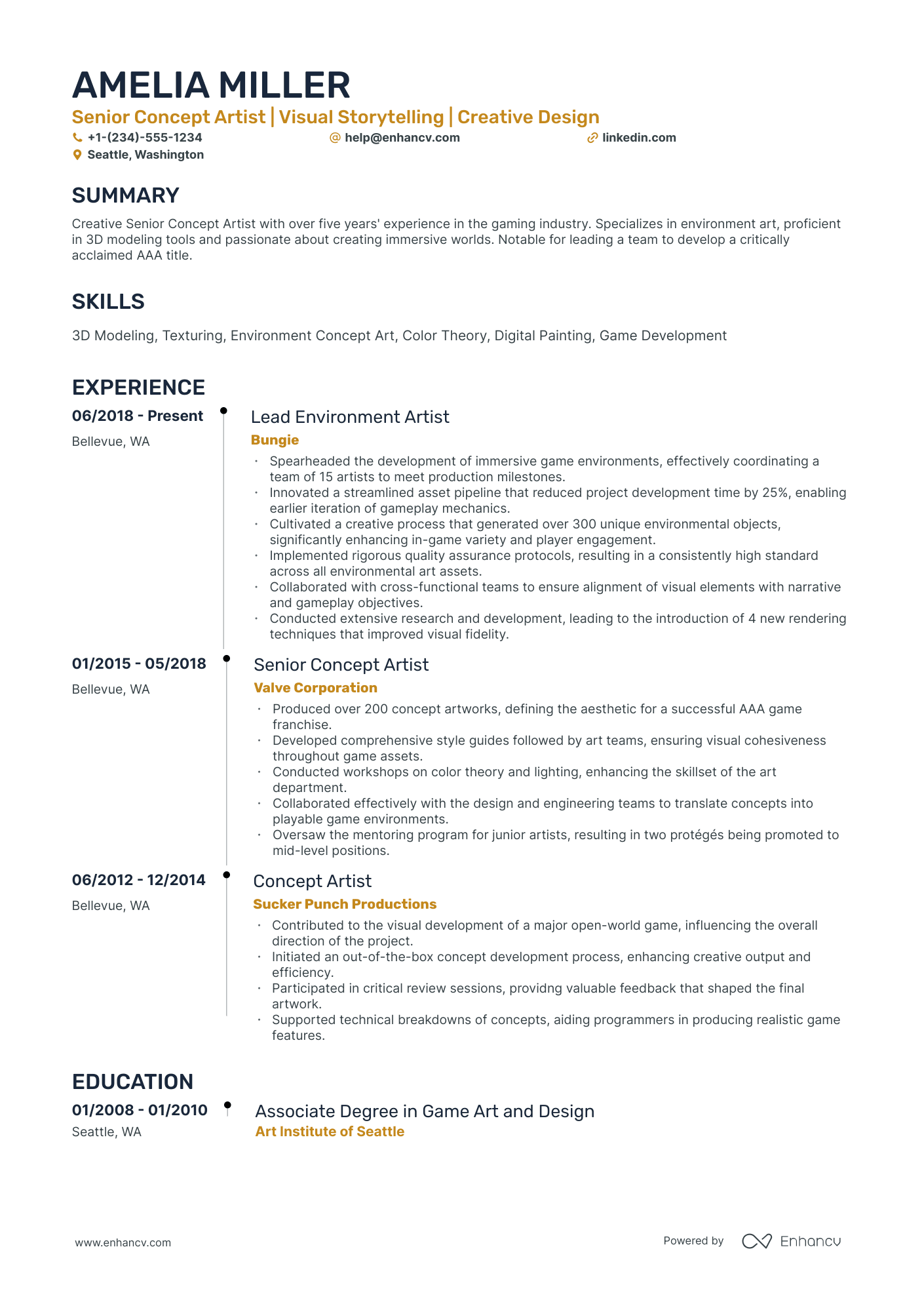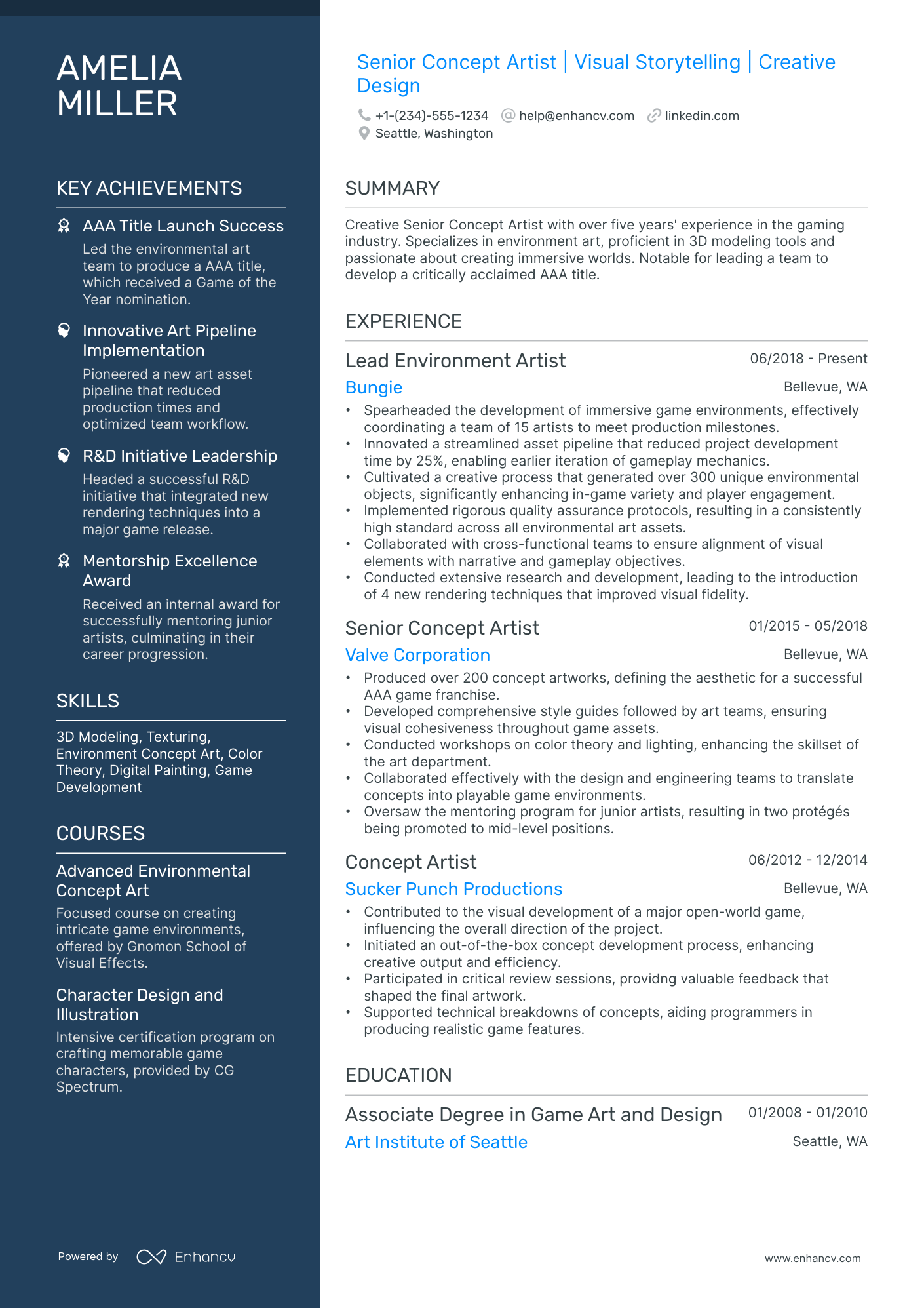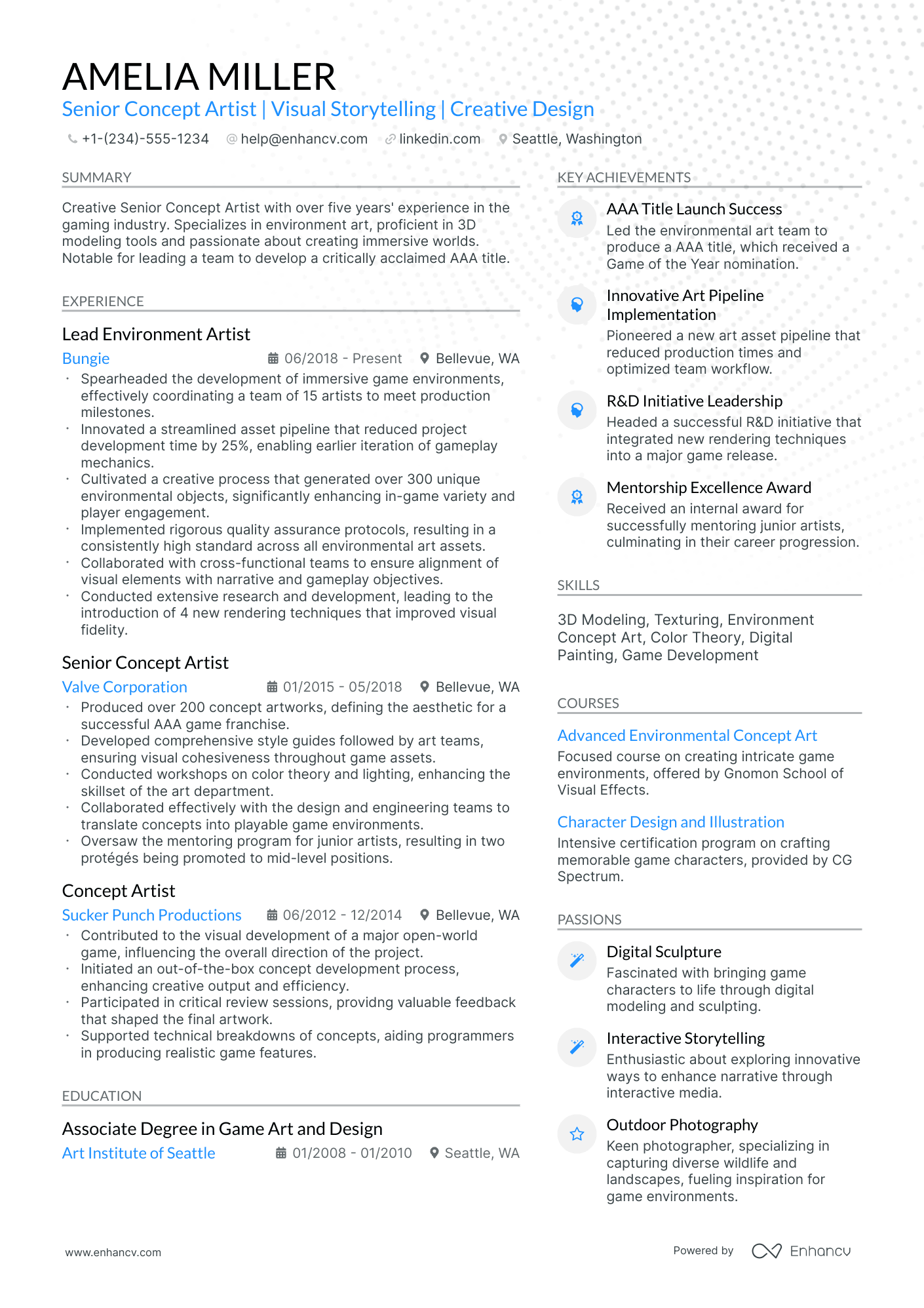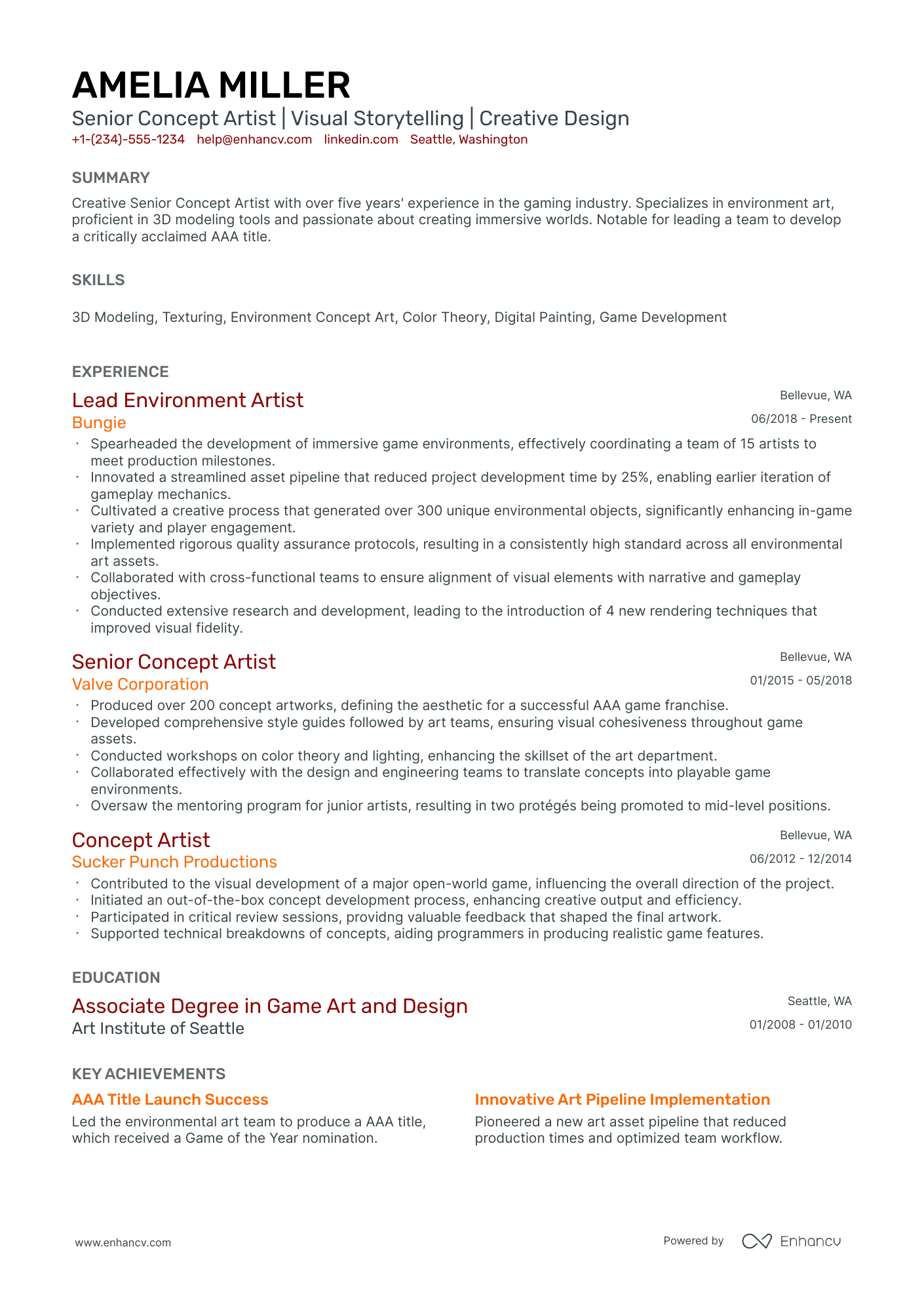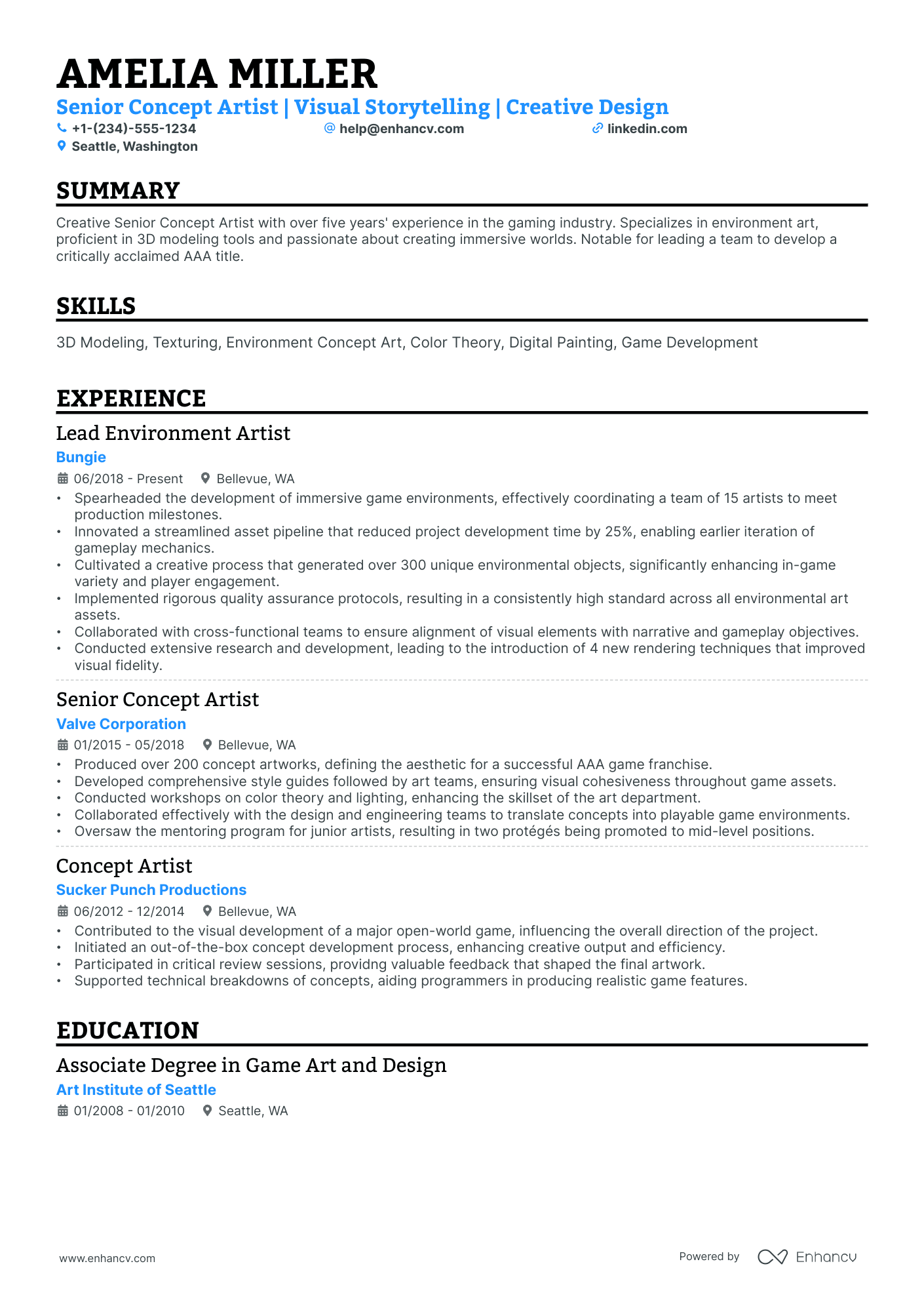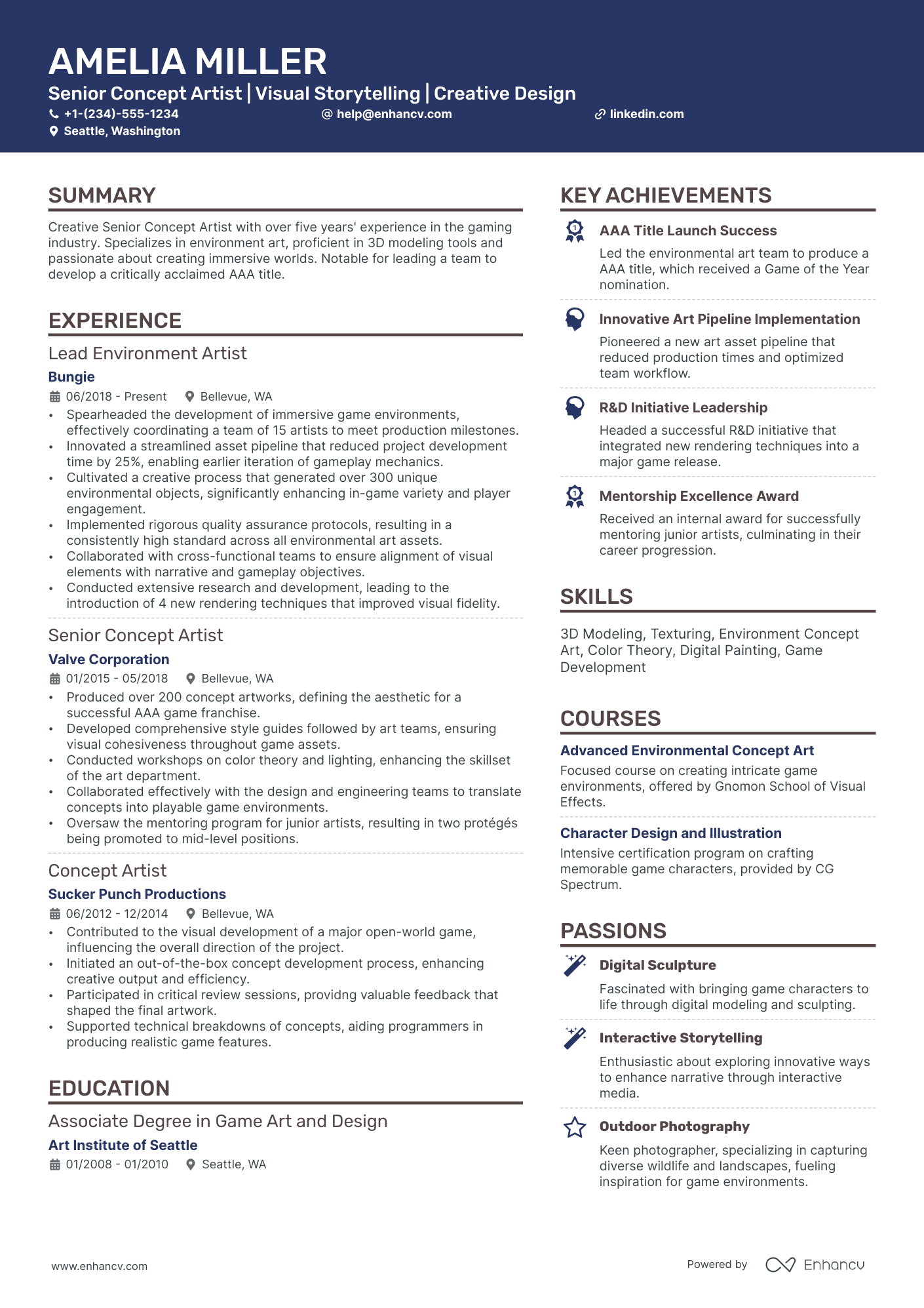As a concept artist, one resume challenge you may struggle with is effectively showcasing your diverse project portfolio while adhering to industry standards. Our guide provides you with targeted strategies to highlight your artistic range and present it in a professional format that will capture the attention of potential employers.
- The most straightforward and effective resume format, ensuring your concept art resume stands out among numerous candidate profiles;
- The significance of the top one-third of your resume, including the header, summary or objective, and skills section, and its impact on recruiters;
- Frameworks and structures used by real concept art professionals, offering insights on how to enhance your resume with industry-specific expertise;
- A variety of concept art resume sections that bolster your profile, showcasing your comprehensive capabilities and distinctiveness.
Gaining insights from the best has never been easier. Explore more concept art resume examples below:
How to style your concept art resume: layout and format
When creating your concept art resume, have you ever wondered how long it should be? Experts point out that it should be between one and two pages. Choose the longer format, if you happen to have over a decade of relevant experience. What is more, resume formats play a crucial role in presenting your experience. Use the:- Reverse-chronological resume format to highlight your experience;
- Functional skill-based resume format if you have less experience and want to focus on skills;
- Hybrid resume format to guide recruiters through both your experience and skills.
- Make sure your headline is simple and includes the job you're applying for or your current role, an abbreviation of a certificate you have, or even your professional area of interest;
- Always tailor your concept art resume to the role you're applying for by matching job requirements to your experience via different resume sections;
- Once you've created your resume, download it in PDF (unless otherwise specified). This is to ensure readability and that the layout remains fixed.
Each market has its own resume standards – a Canadian resume layout may differ, for example.
Upload & Check Your Resume
Drop your resume here or choose a file. PDF & DOCX only. Max 2MB file size.
PRO TIP
Mention specific courses or projects that are pertinent to the job you're applying for.
Traditional sections, appreciated by recruiters, for your concept art resume:
- Clear and concise header with relevant links and contact details
- Summary or objective with precise snapshot of our career highlights and why you're a suitable candidate for the concept art role
- Experience that goes into the nuts and bolts of your professional qualifications and success
- Skills section(-s) for more in-depth talent-alignment between job keywords and your own profile
- Education and certifications sections to further show your commitment for growth in the specific niche
What recruiters want to see on your resume:
- Strong portfolio showcasing diverse styles, creativity, and an understanding of visual storytelling
- Proficiency with industry-standard software such as Photoshop, Illustrator, or 3D modeling tools like ZBrush or Maya
- Previous experience with project-specific artwork, such as character design, environment design, or prop design for games, films, or animations
- Ability to work collaboratively, take direction, and integrate feedback from art directors or other team members
- Understanding of the production pipeline and ability to deliver concept art that aligns with the technical constraints and art direction of the project
Writing your concept art resume experience
Within the body of your concept art resume is perhaps one of the most important sections - the resume experience one. Here are five quick tips on how to curate your concept art professional experience:
- Include your expertise that aligns to the job requirements;
- Always ensure that you qualify your achievements by including a skill, what you did, and the results your responsibility led to;
- When writing each experience bullet, ensure you're using active language;
- If you can include a personal skill you've grown, thanks to your experience, this would help you stand out;
- Be specific about your professional experience - it's not enough that you can "communicate", but rather what's your communication track record?
Wondering how other professionals in the industry are presenting their job-winning concept art resumes? Check out how these concept art professionals put some of our best practices into action:
- Led a team of 5 artists to create compelling character concepts for 'Epic Questline', a top-rated mobile RPG, enhancing character appeal and contributing to a 20% increase in game downloads.
- Collaborated closely with the game design and narrative teams to ensure character designs were consistent with the world lore, resulting in a strong, cohesive game universe praised in industry reviews.
- Implemented a new digital painting workflow using Adobe Photoshop and Blender, reducing concept turnaround time by 35% while maintaining high artistic standards.
- Spearheaded the visual development for 'Galactic Frontiers', an award-winning sci-fi strategy game that sold over 1.5 million copies in the first year post-launch.
- Developed and maintained style guides used by the art department, ensuring artistic cohesion throughout the game development process and enhancing team efficiency by 25%.
- Organized monthly training sessions for concept artists to improve their skills in digital illustration, resulting in higher quality art assets and increased team morale.
- Designed over 100 unique environmental assets for 'New Dawn', an open-world adventure game, which players commended for its immersive and diverse settings.
- Collaborated with the art director to evolve the game's aesthetic, influencing the final look of several major game zones and positively impacting player retention metrics.
- Authored an internal whitepaper on the integration of traditional sketching techniques with 3D modeling software to enhance preliminary concept phases, adopted by the art department.
- Commissioned to visualize and bring to life the main characters for 'Shadow and Steel', an indie action game that successfully raised $200,000 on Kickstarter.
- Utilized both digital and traditional media to create concept artwork, providing the client with versatile visual materials for marketing campaigns.
- Worked under tight deadlines to deliver character and environment concepts for gameplay prototypes, which helped secure early funding from angel investors.
- Participated in the conceptualization of 'Aether Chronicles', a steampunk strategy game, contributing to a 50% improvement in visual storytelling as reported in player surveys.
- Assisted in creating promotional art materials which were pivotal in the game's presence at major gaming conventions, amplifying media reach and pre-order sales.
- Engaged in rigorous concept art testing and adjustment phases, ensuring that every art piece aligned perfectly with the game designers' and narrative team's vision.
- Key artist in the development of 'Chronicles of the Ancients', a fantasy MMORPG, resulting in a game environment that earned praise for its originality and attention to detail.
- Created extensive creature designs that became central to the game's lore, leading to a line of successful merchandise including figurines and artwork prints.
- Introduced the use of VR sketching tools into the concept art process, which greatly enhanced the immersive experience of brainstorming sessions and design reviews.
- Played a pivotal role in the visual development of 'Legends Reborn', a turn-based strategy game that saw a player base growth of 150% after its second expansion.
- Streamlined the concept art pipeline by integrating cloud-based collaboration tools, fostering better communication between remote team members.
- Implemented a feedback loop for concept art submissions which increased the team's ability to meet project milestones on time by 40%.
- Played a central role in creating the signature look for 'Mythic Quest', a fantasy game that was featured in Apple's keynote event as a showcase of iPad graphic capabilities.
- Developed a series of iconic creature designs that went viral on social media, contributing to a substantial pre-launch interest and over 500,000 day-one signups.
- Pioneered the adoption of AI-assisted design tools within the company, which improved the detail and texture work on concept art by 50%.
- Collaborated on the art team for 'Rogue Galaxy', a space exploration game that won 'Best Art Direction' at the Game Developer's Choice Awards.
- Generated environmental sketches that set the tone for numerous levels in the game, which were noted as being instrumental to the game's immersive experience.
- Contributed to cross-functional brainstorming sessions that led to the creation of a fan-favorite antagonist, spurring an increase in community engagement.
- Overseeing the art department for 'Titan's Fall', a mech-based shooter game, guiding it towards winning 'Best Visuals' at the IGN Game Awards.
- Instrumental in developing a unique visual language for the game that has been lauded for its creativity and stand-out art in a crowded market.
- Enhanced the efficiency of the concept phase by 45% by introducing an iterative approach to design critiques, allowing for rapid refinement of art assets.
Quantifying impact on your resume
- Include the number of concept art projects completed to demonstrate experience and productivity.
- List the specific genres or industries where your concept art has been utilized to show versatility and market reach.
- Mention the size of teams you've collaborated with on projects to highlight teamwork and project management skills.
- Quantify the number of tools and software programs mastered to emphasize technical proficiency.
- Provide figures reflecting the scale of projects in terms of budget or assets created to establish your experience with significant productions.
- State the number of times your work was featured in publications or exhibitions to showcase recognition in the field.
- Detail the percentage of projects that were completed on or ahead of schedule to prove efficiency and time management.
- Enumerate any awards or accolades received to demonstrate excellence and peer acknowledgment in concept artistry.
Action verbs for your concept art resume
How to shift the focus from your concept art resume experience section to your professional profile
If you're at the start of your career journey or transitioning industries, you might be concerned about the lack of professional experience while crafting your concept art resume.
How can you effectively present your concept art resume experience section under these circumstances?
Rather than a traditional, extensive experience section, demonstrate your expertise through:
- Emphasizing your education. Your academic background might impress recruiters, especially if it includes recent, industry-relevant knowledge;
- Creating a compelling objective statement. The first few sentences of your resume should map out your motivations and career aspirations, offering insight into your goals;
- Highlighting your transferable skills. For example, if you've honed communication skills through volunteering, illustrate on your concept art resume how these can benefit a potential employer;
- Detailing your technical background in certifications and skills sections. As a recent graduate, your technological foundations might be particularly attractive to employers looking to develop these skills further.
It's important to remember that employers sometimes prefer candidates with less experience but who are a better cultural fit for their organization.
Recommended reads:
PRO TIP
List your educational qualifications and certifications in reverse chronological order.
Balancing hard and soft skills in your concept art resume
Recruiters indeed pay close attention to the specific hard and soft skills candidates possess. Hard skills refer to technical abilities or your proficiency in technologies, while soft skills are the personal attributes and qualities developed over your lifetime.
If you're unsure about effectively quantifying these skills on your resume, follow our step-by-step guide. It's crucial to first understand the key job requirements for the role. Doing so enables you to accurately list your:
- Hard skills in sections like skills, education, and certifications. Your technical expertise is straightforward to quantify. Most organizations find it sufficient to mention the certificates you've earned, along with your proficiency level.
- Soft skills within your experience, achievements, strengths, etc. Defining interpersonal communication traits in your resume can be challenging. Focus on showcasing the accomplishments you've achieved through these skills.
Remember, when tailoring your concept art resume, ensure that the skills you list match exactly with those in the job requirements. For instance, if the job listing specifies "Microsoft Word," include this exact term rather than just "Word" or "MSO."
Top skills for your concept art resume:
Adobe Photoshop
Corel Painter
Sketchbook Pro
Blender
Maya
ZBrush
Procreate
Unity
3ds Max
Illustrator
Creativity
Communication
Collaboration
Time Management
Attention to Detail
Problem Solving
Adaptability
Critical Thinking
Artistic Vision
Self-Motivation
PRO TIP
The more trusted the organization you've attained your certificate (or degree) from, the more credible your skill set would be.
Maximizing your concept art resume: education and certification sections
To effectively showcase your industry knowledge in your concept art resume, it's important to properly list your education and certifications.
For the education section, ensure you include:
- Higher education degrees pertinent to the industry or those at a postgraduate level;
- The start and end dates of your education, along with the name of the institution you graduated from;
- Your GPA and relevant coursework, but only if they are impressive and applicable to the role.
Additionally, create a separate certifications section to spotlight your most notable recognitions. Another excellent place to feature a leading industry certificate is in your resume header, right after your name.
Below is a list of key industry certifications that are often sought after by recruiters
The top 5 certifications for your concept art resume:
- Certified concept artist (CCA) - International Digital Media & Arts Association (iDMAa)
- Adobe Certified Expert (ACE) - Adobe
- Autodesk Certified Professional (ACP) - Autodesk
- Certified Illustrator (CI) - Graphic Artists Guild
- Concept art Diploma (CAD) - CG Spectrum College of Digital Art & Animation
PRO TIP
If you happen to have some basic certificates, don't invest too much of your concept art resume real estate in them. Instead, list them within the skills section or as part of your relevant experience. This way you'd ensure you meet all job requirements while dedicating your certificates to only the most in-demand certification across the industry.
Recommended reads:
Should you write a resume summary or an objective?
No need to research social media or ask ChatGPT to find out if the summary or objective is right for your concept art resume.
- Experienced candidates always tend to go for resume summaries. The summary is a three to five sentence long paragraph that narrates your career highlights and aligns your experience to the role. In it you can add your top skills and career achievements that are most impressive.
- Junior professionals or those making a career change, should write a resume objective. These shouldn't be longer than five sentences and should detail your career goals . Basically, how you see yourself growing in the current position and how would your experience or skill set could help out your potential employers.
Think of both the resume summary and objective as your opportunity to put your best foot forward - from the get go - answering job requirements with skills.
Use the below real-world concept art professional statements as inspiration for writing your resume summary or objective.
Resume summaries for a concept art job
- With over 5 years of dedicated experience in gaming concept artistry at a leading studio, a portfolio enriched with high-fantasy and dystopian environment designs, and a proven track record of conceptualizing and executing visionary art for top tier gaming titles, I bring a wealth of expertise and a deep understanding of visual storytelling to the table.
- Seasoned digital illustrator with a decade of experience in creating compelling characters and worlds for children's book publishing, looking to transition into concept artistry with a strong grasp of color theory, composition, and digital painting techniques honed through years of crafting engaging narratives for young audiences.
- Adept in marrying the latest 3D modeling techniques with traditional hand-drawn illustration, I bring 7 years of experience from the animation industry and an impressive portfolio featuring work used in widely acclaimed animated features, ready to infuse that hybrid vigor into the realm of video game concept artistry.
- Professional graphic designer with 6 years of corporate branding experience, aspiring to pivot into concept art with a solid foundation in design principles, a keen eye for aesthetics, and a passion for creating immersive environments and innovative character designs that resonate with diverse audiences.
- Eager to embark on a career in concept art, I am armed with a fresh perspective, a relentless drive to create groundbreaking visual art, and a commitment to mastering the indispensable tools and software integral to the industry while maintaining an unwavering focus on narrative-centric design.
- With a recent degree in Fine Arts and a tireless enthusiasm for digital creation, I aim to harness my foundational skills in composition, color, and anatomy to contribute to high-quality concept art outputs, translating fantastical ideas into tangible assets that propel narrative and gameplay experiences.
Optimize your resume summary and objective for ATS
Drop your resume here or choose a file.
PDF & DOCX only. Max 2MB file size.
Extra sections to include in your concept art resume
What should you do if you happen to have some space left on your resume, and want to highlight other aspects of your profile that you deem are relevant to the role? Add to your concept art resume some of these personal and professional sections:
- Passions/Interests - to detail how you spend both your personal and professional time, invested in various hobbies;
- Awards - to present those niche accolades that make your experience unique;
- Publications - an excellent choice for professionals, who have just graduated from university or are used to a more academic setting;
- Volunteering - your footprint within your local (or national/international) community.
Key takeaways
- The logic of your resume presentation should follow your career highlights and alignment with the role;
- Curate information within different sections (e.g. summary, experience, etc.) that helps highlight your strengths;
- Exclude from your resume irrelevant experience items - that way you'd ensure it stays no longer than two pages and is easy to read;
- Dedicate space within the summary, experience, and/or achievements to highlight precisely why you're the best candidate for the role via your previous success;
- Both your technical and people capabilities should also play a crucial role in building up your concept art application. Prove your skill set in various resume sections.
